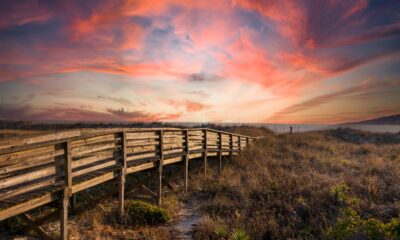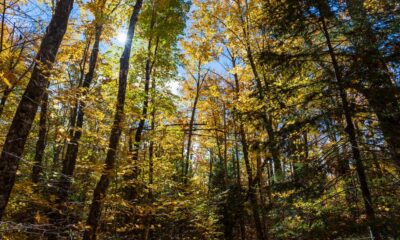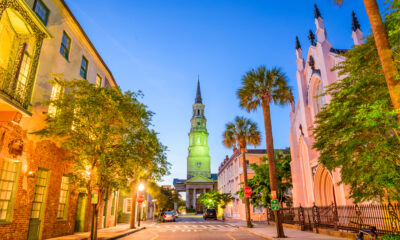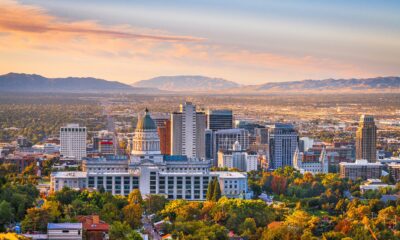Idaho
How empty-handed Yankees from Montana branded this Idaho gold country forever
Published
55 minutes agoon
By
Leo Heit
Joel Richardson’s Failed 1866 Yankee Fork Expedition
In 1866, Joel Richardson led a band of hopeful Montana men to Idaho Territory, chasing gold dreams along a Salmon River tributary. They dug for weeks but found nothing worth keeping.
Still, they left their mark. Since every man hailed from the Northeast, they dubbed it “Yankee Fork” before heading home broke.
Four years later, others struck gold in the same area, and soon Bonanza City grew to 2,000 people.
The Yankee Fork Gold Dredge still stands today as a monument to the boom that followed Richardson’s bust, with photos showing the very men who finally struck it rich where the Yankees once failed.

Gold Fever Hit Montana During the Civil War
John White found gold at Grasshopper Creek near Bannack on July 28, 1862, starting Montana’s first big gold rush while the Civil War raged back east.
By spring 1863, Bannack grew to 3,000 people, with violent thieves targeting gold shipments between mining camps.
The Alder Gulch find in May 1863 by Fairweather and Edgar created Virginia City, with some of the richest gold fields in the world.
Montana Territory formed in 1864 because of these gold finds and the quick growth they caused.

Yankees Grouped Together to Follow Idaho Gold Rumors
Joel Richardson gathered Montana prospectors around 1866 or 1867 to look for new gold fields beyond the crowded Montana camps.
Every member of his group was a Yankee, giving them a clear regional identity that later became important. The group left Montana’s busy mining areas looking for untapped gold in nearby Idaho Territory.
They followed the common pattern after the Civil War of experienced miners moving west from known fields into new areas.

The Trip to Salmon River Country Tested Their Grit
Richardson’s group traveled to a big stream of the upper Salmon River in what later became the Yankee Fork area. The remote spot needed careful planning and lots of supplies for weeks of work far from towns.
Idaho Territory in the 1860s had huge unexplored areas that pulled gold seekers from busy camps. The stream they picked looked good for gold mining based on its features and rocks similar to successful Montana spots.

Wilderness Camp Life Meant Doing Everything Themselves
The gold seekers set up camp along the stream and began careful prospecting that lasted several weeks. They used standard gold mining methods like panning and simple sluicing to test the gravels.
Their remote spot meant complete self-reliance with no nearby stores or towns to help them. Camp life needed organization for cooking, fixing tools, and safety in the wild, with each man handling specific jobs.

Searching for Dreams in Creek Gravels
The group carefully tested gravels along the stream using gold pans and basic tools to look for color. They checked promising rock formations and worked different parts of the creek bed where gold might collect.
Their regular prospecting involved sampling upstream and downstream areas to find possible deposits worth working. Each morning brought fresh hopes of finding gold fields that would make their hard trip worthwhile.

Empty Pans Crushed Their Gold Dreams
After several weeks of hard work, Richardson’s group found no good gold deposits to reward their efforts. The creek gravels had too little gold to make a permanent mining operation worth it in such a remote spot.
Their testing showed the stream lacked the rich deposits needed for profitable mining. The bad results meant their time and supplies brought no return, forcing them to make the tough choice to leave.

A Creek Gets Its Name From Failed Miners
Before heading back to Montana with nothing, Richardson’s group called the creek “Yankee Fork” of the Salmon River simply because everyone in their group was a Yankee.
The name stuck as a lasting mark of their failed trip and regional identity, though they never thought it would become historically important.
This naming followed a common practice among prospectors who left geographic names across the West. Their casual label set this stream apart from other forks of the Salmon River on maps and in miners’ talks.

The Beaten Prospectors Walked Back to Montana
The sad prospectors packed their gear and left their temporary camp without finding the fortune they wanted.
They returned to Montana’s busy mining areas with nothing to show for weeks of hard work except sore backs and empty pockets.
Their failed trip joined countless similar stories of prospectors who found nothing despite their best efforts.
The group likely went back to working known fields around Bannack, Virginia City, or other busy camps where they could at least make a living.

Gold Finally Showed Up Four Years After Richardson Left
Four years later in 1870, Sylvester Jordan and Captain Dudley B. Varney struck gold along Jordan Creek, a small stream of the Yankee Fork that Richardson’s group had missed. Jordan Creek got its name from Sylvester Jordan after this good find put the area on mining maps.
Their discovery proved the area actually held the gold that Richardson’s group had missed during their earlier work.
The good find triggered the creation of the Yankee Fork Mining District, bringing miners rushing into the area.

Boom Towns Grew Where Richardson Found Nothing
After the 1870 discovery, the Yankee Fork Mining District formed, covering all lands drained by the Yankee Fork and its streams.
Charles Franklin started Bonanza in 1877 as the first mining camp along the Yankee Fork to serve the growing crowd of gold seekers and miners.
Custer sprang up in early 1879 right below the General Custer mill site, built by Sam Holman to support mining work.
The town of Challis appeared in 1876 as a center for sending goods to the Yankee Fork mines, connecting the remote area to outside markets.

Failed Prospectors Left a Name That Outlasted the Gold
By the 1880s, Custer grew to 600 people while Bonanza boomed to over 2,000 as the Lucky Boy, General Custer and Montana mines pulled rich ore from the mountains.
Richardson’s failed 1866 expedition ironically provided the enduring name for one of Idaho’s most productive mining districts.
The “Yankee Fork” name stuck through decades of successful mining operations and remains the official designation today.
The area now lives on as the Land of the Yankee Fork Historic Area, welcoming thousands of visitors annually who come to see where Richardson’s Yankees once walked away empty-handed.

Visiting Yankee Fork Gold Dredge, Idaho
The Yankee Fork Gold Dredge at 300 Yankee Fork Road near Stanley shows you the massive 988-ton machine that searched for gold in this area.
You can take self-guided tours for $5 (kids $1) from late May through Labor Day, 10am to 4:30pm daily. Volunteers answer questions as you explore the complete interior with diesel engines and sluice boxes.
The fork got its name from Joel Richardson’s 1866 prospecting party of Yankees who left empty-handed.
This article was created with AI assistance and human editing.
Read more from this brand:
Currently residing in Phoenix, Arizona with his wife and Pomeranian, Mochi. Leo is a lover of all things travel related outside and inside the United States. Leo has been to every continent and continues to push to reach his goals of visiting every country someday. Learn more about Leo on Muck Rack.


This clever Marine cheated his way into WWII, then spent 22 years rebuilding Honolulu

At 17, she shot a Union soldier in her foyer – then became the Confederacy’s deadliest spy

New Orleans’ “Black Day” claimed 230 lives in 24 hours – and the rich of the 1850s couldn’t escape

How empty-handed Yankees from Montana branded this Idaho gold country forever

Cozy fall escapes and Oktoberfest fun in Leavenworth this October

12 Reasons Why You Should Never Ever Move to Florida

Best national parks for a quiet September visit

In 1907, Congress forced Roosevelt to put God back on U.S. coins. Here’s why.

The radioactive secret White Sands kept from New Mexicans for 30 years

America’s most famous railroad photo erased 12,000 Chinese workers from history
Trending Posts

 Pennsylvania5 days ago
Pennsylvania5 days agoHere Are 12 Things People from Pennsylvania Do That Seem Insane To Everyone Else

 North Carolina6 days ago
North Carolina6 days agoHere Are 12 Things People from North Carolina Do That Seem Insane To Everyone Else

 Maine7 days ago
Maine7 days agoThe ruins of a town that time forgot are resting in this Maine state park

 New York6 days ago
New York6 days agoHere Are 12 Things People from New York Do That Seem Insane To Everyone Else

 South Carolina4 days ago
South Carolina4 days agoHere Are 12 Things People from South Carolina Do That Seem Insane To Everyone Else

 Ohio6 days ago
Ohio6 days agoHere Are 12 Things People from Ohio Do That Seem Insane To Everyone Else

 Utah3 days ago
Utah3 days agoHere Are 12 Things People from Utah Do That Seem Insane To Everyone Else

 Oklahoma5 days ago
Oklahoma5 days agoHere Are 12 Things People from Oklahoma Do That Seem Insane To Everyone Else
